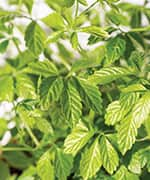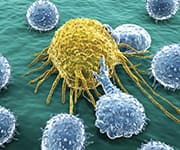Life Extension Magazine.
Searching for plants with anti-cancer activity, scientists focused on a vine native to parts of Asia called Gynostemma pentaphyllum.
Long used to promote longevity, modern research has identified in it a treasure trove of anti-cancer compounds.1
A review paper of cell and animal studies presented data on Gynostemma’s potential effects against leukemia, colon cancer, prostate cancer, lung cancer, breast cancer, and more.1
Cancer-Fighting Compounds
Gynostemma pentaphyllum contains more than 230 different compounds in multiple classes, including saponins, sterols, flavonoids, and others.1
Dozens of these nutrients have been studied and most have demonstrated anti-cancer activities against different cancer types.
One review article listed 28 specific compounds in Gynostemma that have anti-cancer activity in vitro. That doesn’t include the flavonoids and carotenoids it contains, which also have cancer-fighting properties in vitro.1
Reducing Cancer Growth
Studies in cell cultures and animal models have demonstrated this plant’s anti-cancer properties.1
In animals given Gynostemma, the size and weight of tumors is significantly reduced.2-5
Some of these studies found that Gynostemma attacked cancer cells and boosted the animals’ immune response to the tumor.3,6-8
Gynostemma also appears to have synergistic effects with other anti-cancer compounds. For example, in a mouse model of colorectal cancer, co-treatment with the chemotherapy drug 5-fluorouracil enhanced the drug’s effectiveness.9
Early Human Trials
Evidence from studies in the 1990s mentions that Gynostemma intake enhances immune function even when patients are undergoing chemotherapy, which impairs immune function.1
An early observational study showed lower rates of cancer relapse and metastasis as well as lower mortality rates and improved immune function.
Research interest on the benefits of Gynostemma has increased markedly over the past decades. We await and look forward to reporting new evidence as it becomes available.
How Gynostemma Works
With its many bioactive compounds, Gynostemma induces several beneficial mechanisms all at once.
In general, Gynostemma modulates the activity of several cellular signaling pathways tied to cancer formation and progression.
For example, it activates AMPK, while blocking mTOR and the associated PI3K/Akt. 1,10-12
These pathways are involved in many aspects of cancer progression. These same mechanisms are found for other anti-cancer compounds being explored, such as the drug metformin.
Gynostemma’s mechanisms are associated with effects that have been observed in various studies. Some of the most notable include:1
- Cell cycle arrest. When cancer cells grow and reproduce, they pass through a complex pathway known as the cell cycle. In multiple cancer types, studies have shown that Gynostemma modulates the activity of several proteins involved in cell cycle regulation, stopping the growth of cancer cells.
- Induction of cell death. When normal cells are aged or damaged, they die off through a beneficial process called apoptosis. Cancer cells shut off this process, evading death. Gynostemma acts to re-activate apoptosis, killing off these abnormal cells.
- Inhibition of invasion and metastasis. The lethality of cancers lies mainly in their ability to invade surrounding healthy tissues and metastasize (spread) to distant sites in the body. Gynostemma blocks several pathways involved in invasion and metastasis.
What you need to know
Gynostemma’s Cancer-Fighting Actions
- Gynostemma pentaphyllum, also known as jiaogulan, is an Asian plant containing hundreds of different bioactive compounds. Many have been studied and found to have anti-cancer activities.
- In cell culture and animal models, Gynostemma has been shown to stop the growth and spread of cancer, cause cancer cells to die off, and help the immune system attack cancer.
- Gynostemma acts by modulating the activity of several cellular signaling pathways tied to cancer formation and progression.
- Interfering with cancer cell metabolism. Cancer cells need nutrients and energy to grow. Gynostemma has been found to alter the function of key enzymes involved in cancer cell metabolism, starving cancer cells of energy and further blocking their ability to grow and reproduce.
- Immune support. Gynostemma has been found to support key immune system functions, giving a boost to immune cells such as macrophages, T cells, and NK cells. This helps the body more effectively fight and attack cancer.
This wide range of mechanistic effects makes Gynostemma a potential adjuvant weapon in the battle against cancer.
Summary
Gynostemma pentaphyllum and its extracts contain hundreds of compounds, many of which have demonstrated, in pre-clinical studies, anti-cancer activities against a range of human cancer types.
By acting on different signaling pathways associated with cancer formation and progression, Gynostemma adds yet another ingredient with promising results in the fight against cancer.
Most people use Gynostemma pentaphyllum today to activate cellular AMPK, which suppresses excess mTOR1. This enables many people to lose excess belly fat.
The anti-cancer findings provide another reason for people to include Gynostemma pentaphyllum in their supplement program.
We look forward to new evidence on Gynostemma, which has attracted growing interest in recent decades.
If you have any questions on the scientific content of this article, please call a Life Extension Wellness Specialist at 1-866-864-3027.
References
- Li Y, Lin W, Huang J, et al. Anti-cancer effects of Gynostemma pentaphyllum (Thunb.) Makino (Jiaogulan). Chin Med. 2016;11:43.
- Lin JJ, Hsu HY, Yang JS, et al. Molecular evidence of anti-leukemia activity of gypenosides on human myeloid leukemia HL-60 cells in vitro and in vivo using a HL-60 cells murine xenograft model. Phytomedicine. 2011 Sep 15;18(12):1075-85.
- Liu J, Zhang L, Ren Y, et al. Anticancer and immunoregulatory activity of Gynostemma pentaphyllum polysaccharides in H22 tumor-bearing mice. Int J Biol Macromol. 2014 Aug;69:1-4.
- Lu KW, Chen JC, Lai TY, et al. Gypenosides suppress growth of human oral cancer SAS cells in vitro and in a murine xenograft model: the role of apoptosis mediated by caspase-dependent and caspase-independent pathways. Integr Cancer Ther. 2012 Jun;11(2):129-40.
- Xu C, Wang B, Ren S. The suppressive effect of gypenosides on murine s_(180) sarcoma and cultured erythroleukemia cell line k_(562). Xi’an Yi Ke Da Xue Xue Bao. 2002;23:217-9.
- Du X-Y, Hou Y, Tan H, et al. Studies on the anti-tumor activity of polysaccharide from Gynostemma pentaphyllum and its mechanisms. Sci Technol Eng. 2009;20:5968-72.
- Hsu HY, Yang JS, Lu KW, et al. An experimental study on the antileukemia effects of gypenosides in vitro and in vivo. Integr Cancer Ther. 2011 Mar;10(1):101-12.
- Xu C, Wang B, Ren S. The suppressive effect of gypenosides on murine S180 sarcoma and cultured erythroleukemia cell line K562. Xi’an Yi Ke Da Xue Xue Bao. 2002;23:217-9.
- Kong L, Wang X, Zhang K, et al. Gypenosides Synergistically Enhances the Anti-Tumor Effect of 5-Fluorouracil on Colorectal Cancer In Vitro and In Vivo: A Role for Oxidative Stress-Mediated DNA Damage and p53 Activation. PLoS One. 2015;10(9):e0137888.
- Gauhar R, Hwang SL, Jeong SS, et al. Heat-processed Gynostemma pentaphyllum extract improves obesity in ob/ob mice by activating AMP-activated protein kinase. Biotechnol Lett. 2012 Sep;34(9):1607-16.
- Li X, Liu H, Lv C, et al. Gypenoside-Induced Apoptosis via the PI3K/AKT/mTOR Signaling Pathway in Bladder Cancer. Biomed Res Int. 2022;2022:9304552.
- Liu H, Li X, Duan Y, et al. Mechanism of gypenosides of Gynostemma pentaphyllum inducing apoptosis of renal cell carcinoma by PI3K/AKT/mTOR pathway. J Ethnopharmacol. 2021 May 10;271:113907.








